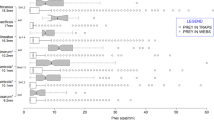Abstract
The costs and benefits of group living can vary among group members depending on their physical location within the group. If individuals can anticipate poor positions and leave the group, the society may dissolve. Therefore, understanding the geometry of social groups is critical to understanding their stability. We examined social geometry in the colonial spider, Cyrtophora citricola (Araneidae), which builds long-lasting individual webs within a shared colony framework. Group foraging benefits are thought to be an ultimate cause for the evolution of colonial living in spiders, but conflict often arises over food and territory. To understand how foraging benefits of grouping interact with inter-individual conflict to shape group geometry, we examined the effects of feeding history and body size on inter-individual spacing in the laboratory. We also examined the effect of spider density and body size on individual position within colonies in a semi-natural setting. We found that spiders with prior food stress increased their inter-individual spacing, suggesting that competition for prey may override group foraging benefits. Larger spiders built their webs first, relegating smaller spiders to the margins of the space and sometimes preventing them from completing web construction. In a semi-natural setting, spiders did not maintain close spacing, but rather spread themselves out over the substrate, and larger spiders occupied the preferred side of the substrate to the exclusion of smaller spiders. Contrary to the hypothesis that foraging advantages to group living promote greater cohesion under food stress, food competition appeared to promote group instability, and exclusion of small spiders by larger and more dominant individuals seemed to determine position in the colony.
Significance statement
In colonial spiders, foraging benefits are thought to be the primary driver of group living, yet there is often conflict over food and territory within the group. We tested the hypothesis that foraging benefits should promote group cohesion under food stress in the colonial spider Cyrtophora citricola. By manipulating prey abundance prior to trials, but minimizing prey cues during trials, we eliminated the influence of prey position on spiders, leaving interactions among individuals to determine spider location. Prior food deprivation caused spiders to space themselves farther apart, refuting the group cohesion hypothesis. Larger spiders prevented smaller spiders from constructing webs and relegated them to less preferred positions in the group, suggesting that aggressive interactions determined spacing and placement within the colony, but that these interactions are modulated by feeding history.





Similar content being viewed by others
References
Andersen P, Gill R (1982) Cox’s regression model for counting processes, a large sample study. Ann Stat 10:1100–1200
Arnott G, Elwood RW (2009) Assessment of fighting ability in animal contests. Anim Behav 77:991–1004
Bailely AM, Rendon NM, O’Malley KJ, Demas GE (2016) Food as a supplementary cue triggers seasonal changes in aggression, but not reproduction, in Siberian hamsters. Physiol Behav 167:298–308
Barta Z, Flynn R, Giraldeau L (1997) Geometry for a selfish foraging group: a genetic algorithm approach. Proc R Soc B 264:1233–1238
Barton RA (1993) Sociospatial mechanisms of feeding competition in female olive baboons, Papio anubis. Anim Behav 46:791–802
Bilde T, Lubin Y (2011) Group living in spiders: cooperative breeding and coloniality. In: Heberstein M (ed) Spider behaviour flexibility and versatility. Cambridge University Press, New York, pp 275–306
Bitetti MS, Janson CH (2001) Social foraging and the finder’s share in the capuchin monkeys, Cebus apella. Anim Behav 62:47–56
Buskirk RE (1975) Coloniality, activity patterns and feeding in a tropical orb-weaving spider. Ecology 56:1314–1328
Cangialosi KR, Uetz GW (1987) Spacing in colonial spiders: effects of environment and experience. Ethology 76:236–246
Caraco T, Uetz GW, Gillespie RG, Giraldeau L-A (1995) Resource consumption variance within and among individuals: on coloniality in spiders. Ecology 76:196–205
Drummond H, Chavelas CG (1989) Food shortage influences of sibling aggression in the blue-footed booby. Anim Behav 37:806–819
Ellsworth EA, Belthoff JR (1999) Effects of social status on the dispersal behavior of juvenile western screech-owls. Anim Behav 57:883–892
Emlen ST (1982) The evolution of helping. I. An ecological constraints model. Am Nat 119:29–39
Fernández Campón F (2007) Group foraging in the colonial spider Parawixia bistriata (Araneidae): effect of resource levels and prey size. Anim Behav 74:1551–1562
Gilbert C, Robertson G, Le Maho Y, Naito Y, Ancel A (2006) Huddling behavior in emperor penguins: dynamics of huddling. Physiol Behav 88:479–488
Hamilton WD (1971) Geometry of the selfish herd. J Theor Biol 31:295–311
Hatchwell BJ, Komdeur J (2000) Ecological constraints, life history traits and the evolution of cooperative breeding. Anim Behav 59:1079–1086
Heesen M, Macdonald S, Ostner J, Schülke O (2015) Ecological and social determinants of group cohesiveness and within-group spatial position in wild Assamese macaques. Ethology 121:270–283
Hemelrijk CK (2000) Towards the integration of social dominance and spatial structure. Anim Behav 59:1035–1048
Hirsch BT (2007) Costs and benefits of within-group spatial position: a feeding competition model. Q Rev Biol 82:9–27
Hodge MA, Uetz GW (1992) Anti-predator benefits of single and mixed-species grouping by Nephila clavipes (L.) (Araneae, Tetragnathidae). J Arachnol 20:212–216
Hodge MA, Uetz GW (1995) A comparison of agonistic behavior of colonial web-building spiders from desert and tropical habitats. Anim Behav 50:963–972
Jakob EM, Marshall SD, Uetz GW (1996) Estimating fitness: a comparison of body condition indices. Oikos 77:61–67
Johannesen J, Wennmann JT, Lubin Y (2012) Dispersal behavior and colony structure in a colonial spider. Behav Ecol Sociobiol 66:1387–1398
Johnstone RA (2000) Models of reproductive skew: a review and synthesis. Ethology 106:5–26
Kim KW (2000) Dispersal behavior in a subsocial spider: group conflict and the effect of food availability. Behav Ecol Sociobiol 48:182–187
Krause J, Ruxton GD (2002) Living in groups. Oxford University Press, Oxford
Leborgne R, Cantarella T, Pasquet A (1998) Colonial life versus solitary life in Cyrtophora citricola (Araneae, Araneidae). Insect Soc 45:125–134
Lubin YD (1974) Adaptive advantages and the evolution of colony formation in Cyrtophora (Araneae: Araneidae). Zool J Linn Soc-Lond 54:321–339
McGowan A, Sharp SP, Simeon M, Hatchwell BJ (2006) Competing for position in the communal roosts of long-tailed tits. Anim Behav 72:1035–1043
Mestre L, Lubin Y (2011) Settling where the food is: prey abundance promotes colony formation and increases group size in a web-building spider. Anim Behav 81(4):741–748
Morrell LJ, Romey WL (2008) Optimal individual positions within animal groups. Behav Ecol 19:909–919
Morrell LJ, Ruxton GD, James R (2010) Spatial positioning in the selfish herd. Behav Ecol 22:16–22
Pasinelli G, Walters JR (2002) Social and environmental factors affect natal dispersal and philopatry of male red-cockaded woodpeckers. Ecology 83:2229–2239
Rao Jammalamadaka S, Sengupta, A (2001) Topics in circular statistics. World Scientific Press, Singapore
Rayor LS, Uetz GW (1990) Trade-offs in foraging success and predation risk with spatial position in colonial spiders. Behav Ecol Sociobiol 27:77–86
Rayor LS, Uetz GW (1993) Ontogenetic shifts within the selfish herd: predation risk and foraging trade-offs change with age in colonial web-building spiders. Oecologia 95:1–8
Rypstra AL (1979) Foraging flocks of spiders: a study of aggregate behavior in Cyrtophora citricola Forskål (Araneae: Araneidae) in West Africa. Behav Ecol Sociobiol 5:291–300
Rypstra AL (1983) The importance of food and space in limiting web-spiders densities; a test using field enclosures. Oecologia 59:312–316
Shen S-F, Reeve HK, Herrnkind W (2010) The brave leader game and the timing of altruism among nonkin. Am Nat 176:242–248
Sherman PW, Lacey EA, Reeve HK, Keller L (1995) Forum: the eusociality continuum. Behav Ecol 6:102–108
Uetz GW (1989) The “ricochet effect” and prey capture in colonial spiders. Oecologia 81:154–159
Uetz GW (1996) Risk sensitivity and the paradox of colonial web-building in spiders. Am Zool 36:459–470
Uetz GW, Cangialosi KR (1986) Genetic differences in social behavior and spacing in populations of Metepeira spinipes, a communal-territorial orb weaver (Araneae, Araneidae). J Arachnol 14:159–173
Uetz GW, Hieber CS (1997) Colonial web-building spiders: balancing costs and benefits of group-living. In: Choe J, Crespi B (eds) The evolution of social behavior in insects and arachnids. Cambridge University Press, New York, pp 458–475
Uetz GW, Kane TC, Stratton GE (1982) Variation in the social grouping tendency of a communal web-building spider. Science 217:547–549
Ventura L (2016) The effect of colony density on fitness and dispersal in the colonial spider Cyrtophora citricola. M.Sc. thesis, Ben-Gurion University of the Negev, Beer Sheva, Israel
Whitehouse MEA, Lubin Y (2005) The functions of societies and the evolution of group living: spider societies as a test case. Biol Rev 80:347–361
Windfinder.com. (2015) Online at www.windfinder.com/windstatistics/tel_aviv_ben_gurion. Accessed 6 December 2015
Yip EC, Lubin Y (2016) Effects of diet restriction on life history in a sexually cannibalistic spider. Biol J Linn Soc 118:410–420
Yip EC, Rayor LS (2014) Maternal care and subsocial behavior in spiders. Biol Rev 89:427–449
Acknowledgements
We thank Iris Musli and all members of the Lubin lab for maintaining prey populations and spider diets. We also thank Ishai Hoffman for net house maintenance. We thank Dr. Elizabeth Jakob and two anonymous reviewers for their helpful comments on the manuscript. Funding to ECY was provided by the Jacob Blaustein Center for Scientific Cooperation and the Kreitman School for Advanced Graduate Studies. We thank the Parks Authority for permission to collect in the Bessor Reserve (permit #40719). The study was funded by the U.S.-Israel Binational Science Foundation, grant #2010178. This is publication no. 943 of the Mitrani Department of Desert Ecology.
Author information
Authors and Affiliations
Corresponding author
Ethics declarations
Data availability
All data generated or analyzed during this study are included in this published article and its supplementary information files.
Additional information
Communicated by J. Pruitt
Electronic supplementary material
ESM 1
(XLSX 49 kb)
Rights and permissions
About this article
Cite this article
Yip, E.C., Levy, T. & Lubin, Y. Bad neighbors: hunger and dominance drive spacing and position in an orb-weaving spider colony. Behav Ecol Sociobiol 71, 128 (2017). https://doi.org/10.1007/s00265-017-2357-6
Received:
Revised:
Accepted:
Published:
DOI: https://doi.org/10.1007/s00265-017-2357-6




